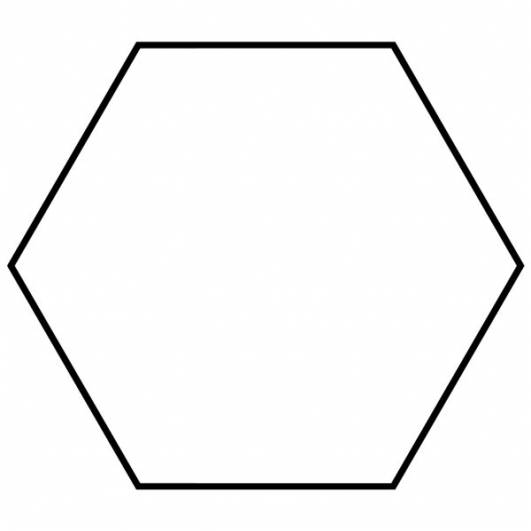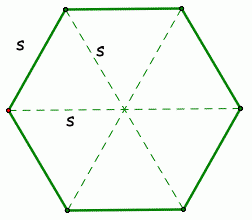So let's say this was the hexagon that was on an 8.5x11 paper and it covered 10% of it:

The area of an 8.5x11 paper must use the formula for the area of a rectangle: Length times width.
A(paper) = 8.5 * 11 = 93.5 in.^2.
Now we have the area of the paper. Recall that the problem states that the hexagon covers 10% of the paper, and therefore has 1/10 of the area of the paper. So:
A(hexagon) = A(paper)/10
We know what the area of the paper is already.
A(hexagon) = 93.5/10
= 9.35 in.^2
Now we know the areas of both shapes and must figure out what the side lengths are. Would you agree that a hexagon looks like 6 equilateral triangles combined? Take a look at this:

Ignore the "s" symbols for the moment.
Recall that the area of an equilateral triangle is base times height divided by 2.
A(triangle) = bh/2
However, in this hexagon, we have six of these triangles. We can use the area of the hexagon to find the area of just one equilateral triangle and multiply that by 6, and then find out our side lengths.
A(triangle) = A(hexagon)/6
A(triangle) = 9.35/6
A(triangle) = bh/2 = 1.558 in.^2 (around that much)
From this point, a bit of trigonometry is going to be involved using right triangles.

Anyway, I drew a line in the middle of the triangle, which represents the height. But forget about that for now. In trigonometry, whenever a shape like this occurred, with a line down the center, there would always be a 30, 60, and 90 degree angle. I labeled that onto the shape. And for the sides opposite to the angle, they represented some length.
30 degree angles are represented as "a".
60 degree angles are represented as "a" multiplied by "sqrt(3)".
90 degree angles are represented as "a" multiplied by 2.
Let's get back to the line down the center of the triangle. That represents height, like I mentioned before. But guess what? It also represents a * sqrt(3). So we can use this as the value for height back into our equation for the triangle.
A(triangle) = 1.558 = [b * a * sqrt(3)]/2
Now to find b. Notice how "a", which is opposite of the 30 degree angle, represents only the left half of the side length of the base. Since it measures only half, we have to multiply it by 2 to give us the length of the entire base of the triangle, which will make it 2a. So b = 2a.
A(triangle) = 1.558 = [2a * a * sqrt(3)]/2
It gets MUCH easier from here, trust me. Simplify the equation to solve for a.
1.558 = [2a^2 * sqrt(3)]/2
1.558 = a^2 * sqrt(3) (the 2 in front of the a^2 cancels out with the 2 dividing the entire right side of the equation)
1.558/sqrt(3) = a^2
a^2 = 0.9
Take the square root of both sides.
a = 0.948
Now that we know what a is, let's backtrack a little bit. Like we said earlier, b = 2a, right? Well, guess what b also represents? The side length of a hexagon!
Yeah, it's a side length of the equilateral triangle, but a hexagon is made up of 6 equilateral triangles, so they will both have the same side lengths.
Side length = 2a
Plug in the value for a.
Side length = 2(0.948) = 1.896 in.